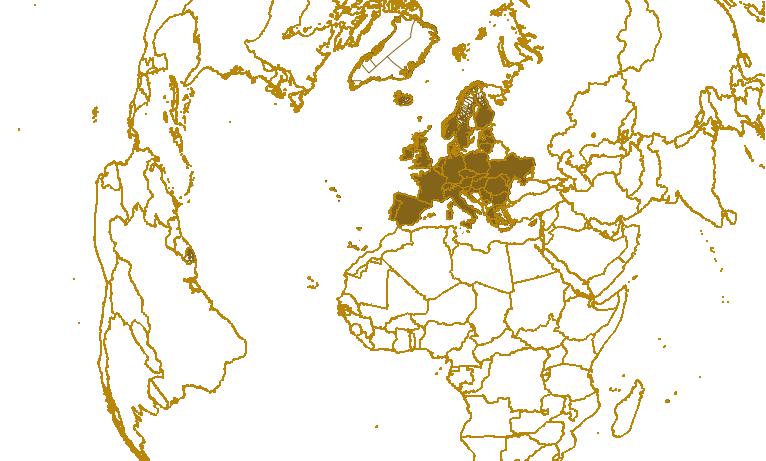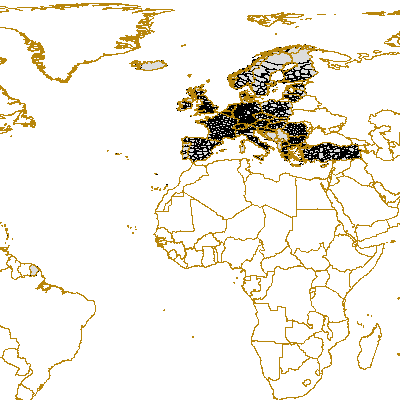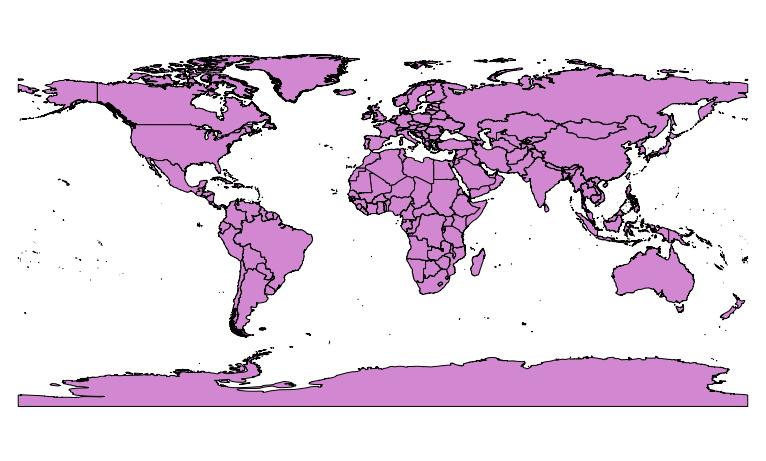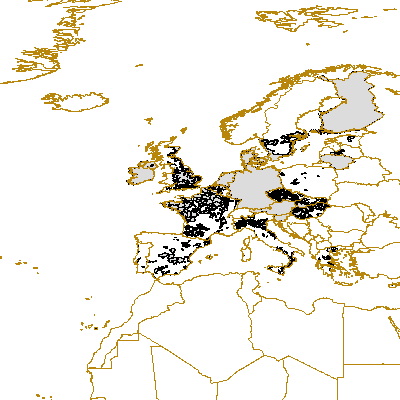geospatial data
Type of resources
Available actions
Topics
INSPIRE themes
Keywords
Contact for the resource
Provided by
Years
Formats
Representation types
Update frequencies
status
Scale
Resolution
-

This data set shows pan European administrative boundaries down to commune level version 2010. Communes are equivalent to Local Administrative Units, level 2 (LAU2), except for GR (LAU1) and SI (so called LAU3). The Nomenclature of Territorial Units for Statistics (NUTS) and the LAU nomenclature are hierarchical classifications of statistical regions that together subdivide the EU economic territory into regions of five different levels (NUTS 1, 2 and 3 and LAU 1, 2, respectively, moving from larger to smaller territorial units). The NUTS classification has been officially established through Regulation (EC) No 1059/2003 of the European Parliament and of the Council and amendments. A non official NUTS-like classification has been defined for the non-EU countries. The LAU classification is not covered by any legislative act. An introduction to the NUTS classification is available here: http://epp.eurostat.ec.europa.eu/portal/page/portal/nuts_nomenclature/introduction The data set is based on EuroBoundaryMap v. 5.0 from Eurogeographics. Geographical extent covers the European Union 27, EFTA countries, Croatia, Serbia (including Kosovo UNSCR 1244) Greenland, Moldova and Ukraine. The scale of the data set is 1:100 000. The data set (100K - 60M) is available to EEA due to EEA having a valid EBM v5.0 licence. These metadata are derived from the original metadata records available at Inspire@EC.
-

The 'GISCO NUTS 2006' dataset represents the NUTS regions by means of region, arc and point topology. The NUTS geographical information is completed by attribute tables and a set of cartographic help lines to better visualise multipart polygonal regions. The NUTS nomenclature is a hierarchical classification of statistical regions defined by Eurostat. The NUTS classification subdivides the EU economic territory into 3 statistical levels. The Regulation (EC) No 1059/2003 of the European Parliament and of the Council on the establishment of a common classification of territorial units for statistics (NUTS) was enforced the 11 July 2003. This regulation provided the NUTS classification with a legal background. Since then, 12 new countries joined the European Union. The NUTS regulation was officially enforced in these 12 countries the day of their accession to the EU. A non official NUTS-like classification has been defined for the EFTA countries, Croatia and Turkey. For further information about the NUTS classification please check the RAMON Eurostat site at http://ec.europa.eu/comm/eurostat/ramon/nuts/home_regions_en.html At present, six scale ranges (100K, 1M, 3M, 10M and 20M, 60M) are maintained in the GISCO geodatabase. The polygon and boundary classes delineate the regions while the points provide a label for each region. Associated tables contain basic information such as the region's name. This feature class represents the polygon geometry of the 1:100.000 scale level of the NUTS regions. This shapefile was modified by the ETC-LUSI with the purpose of including this dataset into the LEAC System.
-

With the help of CLC data it is possible to provide support for protecting ecosystems, halting the loss of biological diversity, tracking the impacts of climate change, assessing developments in agriculture and implementing the EU Water Framework Directive. CLC data is an important data set for the implementation of key priority areas of the Sixth Environment Action Programme of the European Community. CLC data can show, for instance, where fragmentation of the landscape by roads and other infrastructure is worsening and thus increasing the risk that ecosystems can no longer connect with each other, putting the survival of their flora and fauna in danger. In the agricultural field CLC data can highlight where major structural changes are continuing or intensifying, such as the conversion of pasture to arable land, expansion or reduction in the area of fallow land and land taken out of production ('set aside'), or the abandonment of farming altogether. CLC serve as input to the EC 'Inspire' (INfrastructure for SPatial InfoRmation in Europe - http://inspire.jrc.it) initiative. This initiative intends to trigger the creation of a European spatial information infrastructure that delivers to the users integrated spatial information services. CLC programme is also a contribution to the Global Monitoring for Environment and Security (GMES http://gmes.info) initiative, run by the European Commission and the European Space Agency, to provide environmental information from a combination of air- and space-based observation systems and in-situ monitoring.
-

This dataset adds the delineation of a Kosovo under United Nations Security Council Resolution 1244/99 feature to the administrative units at country level from 2010 dataset provided by GISCO. The country identifier (cntr_id) for the Kosovo under United Nations Security Council Resolution 1244/99 feature is set to 'XK' and its associated object_id to 999. Users should pay attention to the existence of another feature with cntr_id set to 'XK' in Africa (associated object_id: 245). The Kosovo under United Nations Security Council Resolution 1244/99 feature has been delineated using the boundaries of the following communes extracted from the administrative units at commune level from 2010 provided by GISCO: comm_id --------- RS01, RS02, RS03, RS04, RS05, RS06, RS07, RS08, RS09, RS10, RS11, RS12, RS13, RS14, RS15, RS16, RS17, RS18, RS19, RS20, RS21, RS22, RS23, RS24, RS25, RS26, RS27, RS28, RS29, RS30, RS31, RS32, RS33, RS34, RS35, RS36, RS37
-

Land Cover Accounts are part of the Land and Ecosystem Accounting project which deal with data on changes in land cover and land use and seek to trace the wider environmental, social and economic implications of these transformations.
-

Data on designated nitrate vulnerable zones as submitted by Member States for monitoring progress of implementation of the Nitrate Directive (Council Directive 91/676/EEC of 12 December 1991 concerning the protection of waters against pollution caused by nitrates from agricultural sources). This Directive has the objective of reducing water pollution caused or induced by nitrates from agricultural sources and preventing further such pollution. Waters affected by pollution and waters which could be affected by pollution if action pursuant Article 5 is not taken shall be identified by the Member States in accordance with the criteria set out in Annex I.
-

This dataset adds the delineation of a Kosovo under United Nations Security Council Resolution 1244/99 feature to the administrative units at country level from 2010 dataset provided by GISCO. The country identifier (cntr_id) for the Kosovo under United Nations Security Council Resolution 1244/99 feature is set to 'XK' and its associated object_id to 999. Users should pay attention to the existence of another feature with cntr_id set to 'XK' in Africa (associated object_id: 245). The Kosovo under United Nations Security Council Resolution 1244/99 feature has been delineated using the boundaries of the following communes extracted from the administrative units at commune level from 2010 provided by GISCO: comm_id --------- RS01, RS02, RS03, RS04, RS05, RS06, RS07, RS08, RS09, RS10, RS11, RS12, RS13, RS14, RS15, RS16, RS17, RS18, RS19, RS20, RS21, RS22, RS23, RS24, RS25, RS26, RS27, RS28, RS29, RS30, RS31, RS32, RS33, RS34, RS35, RS36, RS37
-

In the context of Service Level Agreement between JRC and EFSA, a series of datasets have been developed as support to the FATE and the ECOREGION EFSA PPR Working Groups. Soil maps: Organic matter content of the topsoil, pH of the topsoil, Bulk density of the topsoil, Texture of the topsoil, Water content at field capacity. This metadata record is adapted from the orginal one received from JRC.
-

One key parameter for soil erosion modelling is the soil erodibility, expressed as the K- factor in the commonly used soil erosion model USLE (Universal Soil Loss Equation). The K-factor is related to crucial soil factors triggering erosion (organic matter content, soil texture, soil structure, permeability). We calculated soil erodibility using measured soil data, collected during the 2009 LUCAS (Land Use and Cover Area frame Survey) soil survey campaign across the member states of the European Union. The estimation method of soil erodibility is based on the LUCAS point data. Since the density of points has a variety, we have performed a first assessment of Uncertainty based on the number of points in the 10km Grid Cell (dataset called uncertainty.tif available in the same folder as k-factor). Soil erodibility is expressed in [(t ha h)/(ha MJ mm)]. This metadata record is adapted from the orginal one received from JRC.
-
European soil database (ESDB), Dominant STU rasters (Soil Topologycal Units) - version 2.0, May 2006

The European Soil Database (ESDB) contains four discrete datasets: - the Soil Geographical Database of Eurasia at scale 1:1,000,000 (SGDBE) - the Pedotransfer Rules Database (PTRDB) - the Soil Profile Analytical Database of Europa (SPADBE) - the Database of Hydraulic Properties of European Soils (HYPRES) This 1km x 1km raster version release of the database is freely available to the public and contains a 1km raster version of the vector based soil geometry (which is part of the SGDBE). Raster values have been derived using the "features to raster" tool in the Spatial Analyst extension of ArcGIS, the feature layer being a shapefile created from the SGDBE geometrical database to which attributes from SGDBE and PTRDB have been linked according to the "dominant STU" principle for the "dominant STU" rasters. Dominant STU principle: For each SMU (Soil Mapping Unit): a “dominant STU” is associated. (“dominant” in terms of % of area). The value of a soil attribute A (e.g. depth-to-rock) for this SMU would be the value that A has within that dominant STU. The attributes are described at: http://eusoils.jrc.ec.europa.eu/ESDB_Archive/raster_archive/SG_attr.htm http://eusoils.jrc.ec.europa.eu/ESDB_Archive/raster_archive/pt_attr.htm This metadata record is adapted from the orginal one received from JRC.
 RUC Geo-Data catalogue
RUC Geo-Data catalogue